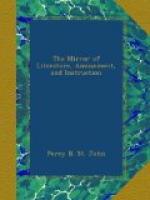The lawn is tastefully varied with parterres of plants; owing to the lateness of the season, we saw but few near flowering, save
Daffodils,
That come before the swallow dares, and
take
The winds of March with beauty, violets
dim,
But sweeter than the lids of Juno’s
eyes,
Or Cytherea’s breath.
A few yards from the lawn a rustic orchestra is in course of erection: whence “the dulcet and harmonious sounds” of music may attune with the joyful inspiration of the natural beauties of the scene. Our guide, (of a more intelligent and communicative character than guides usually are,) directed us by a descending path through the wood, across a rude bridge, past a maze, by a flight of roughly-formed steps, to a terrace, whence we enjoyed a picturesque prospect of great range and indescribable beauty. The woods were as yet leafless, but primroses enlivened the pathside: how touchingly is their solitude told by our poets. Shakspeare calls them
Pale primroses
That die unmarried ere they can behold
Bright Phoebus in his strength.
Milton describes them as dying forsaken:
Bring the rathe primrose that forsaken dies:
and Mayne calls this flower
Lorn tenant of the peaceful glade,
Emblem of virtue in the shade.
Dr. Weatherhead describes the prospect from this terrace with more minuteness than the hazy state of the atmosphere enabled us to trace its several beauties. The ancient archiepiscopal town of Croydon lies at your feet; more remote, Banstead Downs spread a carpet of blooming verdure to the sight; in the extreme distance Windsor Castle peers its majestic towers above the mist; while elsewhere the utmost verge of the horizon is bounded by the bold range of the Surrey and Hampshire hills. Turning to the left you enjoy a view of




